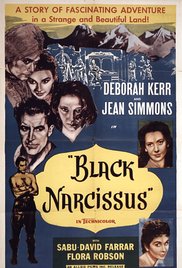Black Narcissus is a religious drama film released in 1947 which was created by the duo Michael Powell and Emeric Pressburger. It's a psychological drama which was different and groundbreaking for its time with the use of matt paintings and exploring themes that had never been previously explored in films. The story centres around a convent of nuns who have moved to a valley in the Himalayas and the emotional tension and lust within the convent which causes issues.
[Fig 2. Film Still]
The story begins in the nuns' original convent where we are faced with a lot of religious imagery such as the cross shaped table. This is relevant later on as when they move to the palace in the himalayas it is decorated much differently much to the distaste of the nun in charge Sister Clodagh, in the first half of the film there is much that is changed about the palace replacing tapestries that they seem unfit and statues to different deities other than christ. This contrast between the two worlds and the will of the nun's to change them is a big part of this film as it is the nun's who live a strict christian life travelling to an isolated village where people go by tradition rather than religion. The nun's constantly question things, such as the old wise man who sits in the same spot all the time yet they want to remove him from the spot. The male progatonist in the story is a British agent known only as Mr Dean who works in the valley where the nuns have been sent. Mr Dean is the focus of the problem of lust for the nuns with one nun (sister Ruth) having such lust for him that she quits the convent to try to be with Mr Dean and this is inevitably where the story takes a sharp downfall into chaos.
The whole film is full of contrasts and conflicts even within the convent. You can see this by the different roles of the nuns even though they are supposedly equal you can see that Sister Ruth is treated bashfully and looked down upon by the other nuns. There is also the distinct contrast between men and women which are rarely seen in today's films, with a stereotypical strong man looking after the sisters being honest with his intentions and the luns who try to restrain their lust for him only showing him disdain. Yet another large contrast is between the locals of the Himalayan valley and the arriving convent who are working to change things about the locals and instill upon them a new religion, finding their way of life bizarre and non-sensical in some cases, such as Sister Clodagh's efforts to remove the holy man from his constant place of sitting.
[Fig 4. Film Still (the localy holy man in his tranquil spot)]
REFERENCE
[1] http://www.imdb.com/title/tt0039192/
[2]https://scribehardonfilm.files.wordpress.com/2012/04/blacknarcissusnuns.jpg
[3]http://offscreen.com/view/holiness_in_black_narcissus
[4]https://www.criterion.com/current/posts/1517-black-narcissus-empire-of-the-senses





Hi Jack,
ReplyDeleteOk, so you have touched on some of the important visual aspects of this film that make it so interesting... it might have been good to go into a little more depth, for example, on the use of colour to show the changing atmospheres, or how the matte paintings were used to extend the scenes.
Don't forget that you are asked to support your own discussions with at least 3 quotes from reputable sources - these need to be referenced using the Harvard method, details of which can be found here -
http://www.uca.ac.uk/library/academic-support/harvard-referencing/
You should also use this method for referencing the images.
Looking forward to reading your next review!